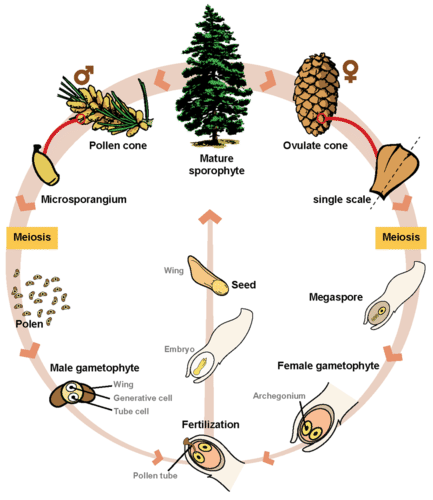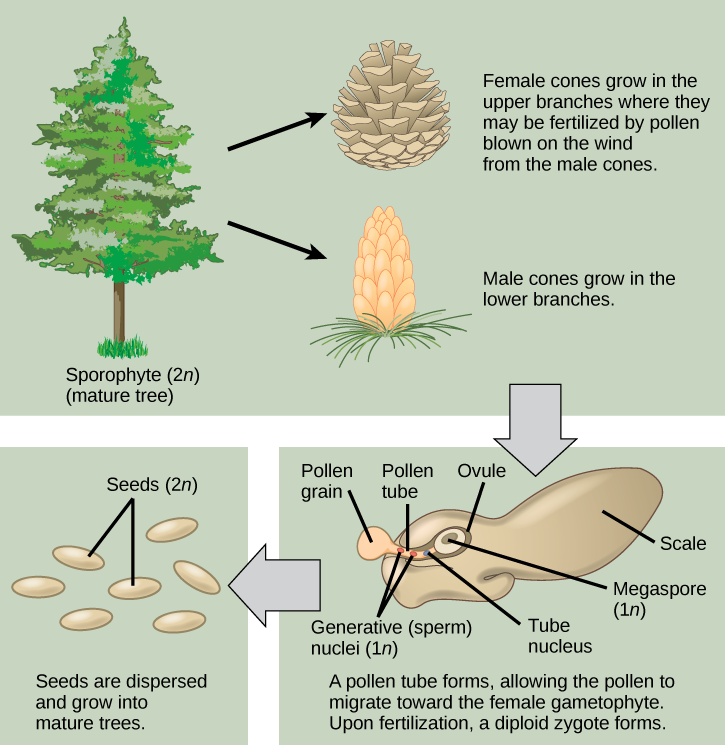Life Cycle of Gymnosperms Study Guide
Introduction
Gymnosperms, which translates as “naked seeds,” are a diverse group of seed plants. According to the “netifer” theory, gnetophytes are sister to conifers, making gymnosperms sister to angiosperms.
Gymnosperm seeds are not encased in an ovary; they are only partially protected by modified leaves known as Sporophylls.. You may recall that Strobilus refers to a dense cluster of sporophylls surrounding a central stalk, as seen in pine cones. When certain seeds mature, they are encased by sporophyte tissues. The integument is the layer of sporophyte tissue that covers the megasporangium and, eventually, the embryo.
Characteristics of gymnosperms include naked seeds, male and female gametophytes, pollen cones and ovulation cones, wind and insect pollination, and tracheids (which transport water and solutes in the vascular system). They are classified into four phyla: coniferophyta, cycadophyta, ginkophyta, and gnetophyta.
Life Cycle of Gymnosperms
Gymnosperms are vascular plants that generate cone-shaped seeds. Conifers, such as pine and spruce trees, are examples. The sporophyte generation is prominent in the gymnosperm life cycle. On the sporophyte parent plant, both gametophytes and the following generation’s young sporophytes develop. The graphic below depicts the life cycle of a gymnosperm. The gymnosperm life cycle follows the general plant life cycle, but with a few new adaptations.
The life cycle of a gymnosperm occurs in several stages, as outlined below.
-
On a mature Sporophyte plant, cones develop. Male spores grow into male gametophytes inside male cones. Each male gametophyte is made up of numerous cells encased in a grain of Pollen.
-
Female spores mature into female gametophytes inside female cones. Each female gametophyte lays an egg within an ovule.
-
Pollen is transported from a male cone to a female cone during pollination. A diploid Zygote is formed when sperm travels from the pollen to an egg and fertilization occurs.
-
The zygote matures into an Embryo within a seed, which emerges from the ovule within the female cone. If the seed germinates, it can develop into a full sporophyte tree, continuing the cycle.
The diploid sporophyte is the major autonomous photosynthetic process of the plant body during the diplontic life cycle. Diploid cells have two sets of chromosomes, while haploid cells only have one. The haploid process is reflected only in gametes. Instead of immediately splitting meiotically to make haploid cells, the zygote divides mitotically to produce a multicellular diploid person in gametic meiosis. Meiosis occurs when cells from diploid people undergo meiosis to form haploid cells or gametes.
In the haplontic life cycle, the haploid cell process is prominent. The zygotic meiosis yields haploid spores. These items will then break mitotically to make new haploids. Male and female gametes will give rise to these haploids. The 2n nucleus state (meaning there are two chromosomes present) exists exclusively in the zygote throughout the haplontic life cycle, and it is very brief.
✅ Conclusion
-
Gymnosperms are seed plants that generate naked seeds and are heterosporous.
-
The sporophyte generation is most prominent in the gymnosperm life cycle.
-
The life cycle of a gymnosperm begins on a mature sporophyte plant.
-
Male spores grow into male gametophytes inside male cones. Each male gametophyte is encased in a grain of pollen.
-
Female spores mature into female gametophytes inside female cones. Each female gametophyte is encased in an egg within an ovule.
-
During pollination, pollen is transported from the male to the female gametophyte where fertilization occurs, creating a zygote.
-
The zygote matures into an embryo within a seed. If the seed germinates, it will develop into a full sphorophyte plant, and the cycle repeats.
FAQs
1. What is a characteristic of the life cycle of gymnosperms?
Gymnosperms have both haploid and diploid life cycles, which means they reproduce through generational alternation. They go through a sporophyte-dominant cycle. The gametophyte stage lasts only a few days. Cones are commonly used as reproductive organs.
2. Do gymnosperms show a diplontic life cycle?
Gymnosperms are sporophytic and diploid in nature. Their gametes, however, are haploid. As a result, they have a diplontic life cycle. This is because the majority of their life cycle is diploid.
3. Where does the gymnosperm life cycle take place?
Gametophyte reproduction occurs in gymnosperms in the form of a cone that grows on the adult sporophyte plant. Each male gametophyte is only a few cells inside a pollen particle. Each female gametophyte lays an egg within an ovule.
4. What stage of the gymnosperm life cycle is the most prevalent?
Gymnosperms are vascular plants that generate cone-shaped seeds. Conifers, such as pine and spruce trees, are examples. The sporophyte generation is prominent in the gymnosperm life cycle. On the sporophyte parent plant, both gametophytes and the following generation’s young sporophytes develop.
5. How are gymnosperms pollinated?
Pollen transfer from the male cone to the female cone occurs in gymnosperms. Self-pollination happens when pollen from the anther is deposited on the stigma of the same flower or another blossom on the same plant.
We hope you enjoyed studying this lesson and learned something cool about the Life Cycle of Gymnosperms! Join our Discord community to get any questions you may have answered and to engage with other students just like you! Don’t forget to download our App to experience our fun, VR classrooms – we promise, it makes studying much more fun! 😎
Sources
-
Life Cycle of Gymnosperms. https://flexbooks.ck12.org/cbook/ck-12-biology-flexbook-2.0/section/9.20/primary/lesson/gymnosperm-life-cycle-bio/ Accessed 11 Dec, 2021.
-
Gymnosperms. https://courses.lumenlearning.com/wm-biology2/chapter/gymnosperms/ Accessed 11 Dec, 2021.
-
Pollination and Fertilization. https://courses.lumenlearning.com/suny-biology2xmaster/chapter/pollination-and-fertilization/ Accessed 11 Dec, 2021.


